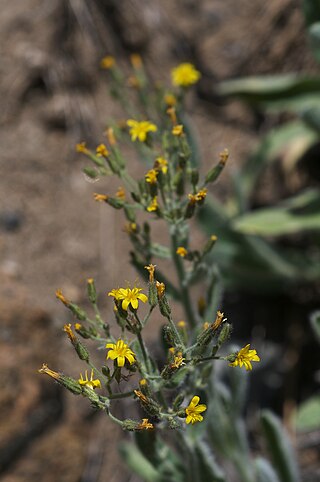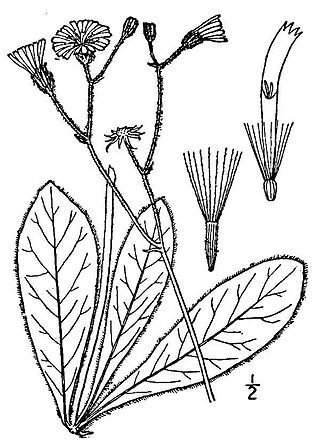
Hieracium , known by the common name hawkweed and classically as hierakion, is a genus of flowering plant in the family Asteraceae, and closely related to dandelion (Taraxacum), chicory (Cichorium), prickly lettuce (Lactuca) and sow thistle (Sonchus), which are part of the tribe Cichorieae. Hawkweeds, with their 10,000+ recorded species and subspecies, do their part to make Asteraceae the second largest family of flowering plants. Some botanists group all these species or subspecies into approximately 800 accepted species, while others prefer to accept several thousand species. Since most hawkweeds reproduce exclusively asexually by means of seeds that are genetically identical to their mother plant, clones or populations that consist of genetically identical plants are formed and some botanists prefer to accept these clones as good species whereas others try to group them into a few hundred more broadly defined species. What is here treated as the single genus Hieracium is now treated by most European experts as two different genera, Hieracium and Pilosella, with species such as Hieracium pilosella, Hieracium floribundum and Hieracium aurantiacum referred to the latter genus. Many members of the genus Pilosella reproduce both by stolons and by seeds, whereas true Hieracium species reproduce only by seeds. In Pilosella, many individual plants are capable of forming both normal sexual and asexual (apomictic) seeds, whereas individual plants of Hieracium only produce one kind of seeds. Another difference is that all species of Pilosella have leaves with smooth (entire) margins whereas most species of Hieracium have distinctly dentate to deeply cut or divided leaves.
A dry roadside dotted with small, ¾ inch red orange flowers, interspersed with very similar yellow ones, and often the white of daisies, is a good sign that you are in Hawkweed country.

Pilosella officinarum, known as mouse-ear hawkweed, is a yellow-flowered species of flowering plant in the daisy family Compositae, native to Europe and northern Asia. It produces single, lemon-coloured inflorescences. Like most hawkweed species, it is highly variable and is a member of a species complex of several dozens of subspecies and hundreds of varieties and forms. It is an allelopathic plant.

Hieracium albiflorum, known by the names white hawkweed and white-flowered hawkweed, is a common and widespread species of plant in the family Asteraceae.

Hieracium umbellatum, the Canadian hawkweed, Canada hawkweed, narrowleaf hawkweed, or northern hawkweed, is a flowering plant in the family Asteraceae.

Coreopsis palmata is a North American species of flowering plant in the family Asteraceae native to North America. Common names include stiff tickseed, wedgeleaf coreopsis, prairie coreopsis, prairie tickseed, and finger coreopsis.

Pilosella caespitosa is like several other Pilosella species and has a similar appearance to many of the hawkweeds.

Hieracium horridum, known as the prickly hawkweed or shaggy hawkweed, is a species of plant in the family Asteraceae. It gets its name from the long, dense, shaggy white to brown hairs (trichomes) which cover all of the plant parts of this plant species. The species is native to Oregon, California, and Nevada in the western United States.

Helenium amarum is a species of annual herb in the daisy family known by the common names yellowdicks, yellow sneezeweed, fiveleaf sneezeweed, and bitter sneezeweed. It is native to much of the south-central United States and northern Mexico, and it is present elsewhere in North America, Australia, and the West Indies as an introduced species.
Hieracium greenei is a species of hawkweed known by the common name Greene's hawkweed.

Hieracium scouleri, known as Scouler's woollyweed, is a species of flowering plant in the tribe Cichorieae within the family Asteraceae. It is native to western North America, from British Columbia and Alberta in Canada, and south to northern California and Utah in the United States.

Artemisia suksdorfii is a North American species of sagebrush in the sunflower family. It is known by the common names coastal mugwort, coastal wormwood, and Suksdorf sagewort. It is native to coastal regions from British Columbia, Washington, Oregon, and northern California as far south as Sonoma County, with isolated populations on Santa Catalina Island in Los Angeles County.

Hieracium argutum is a species of flowering plant in the family Asteraceae known by the common name southern hawkweed.

Hieracium venosum is a species of hawkweed in the tribe Cichorieae within the family Asteraceae. It is widespread and common in south-central Canada (Ontario) and the eastern United States. Its common name comes from the fact that environments it is found in are typically also a home to rattlesnakes.

Hieracium piloselloides is a species of flowering plant in the family Asteraceae known by the common name tall hawkweed. It is native to Europe and it is present in North America as an introduced species and a common weed.

Centaurea macrocephala is a species of flowering plant in the family Asteraceae, and a member of the thistle tribe, Cardueae (Cynareae). It has many common names, including bighead knapweed, big yellow centaurea, lemon fluff, yellow bachelor's button, yellow hardhat, and Armenian basketflower.

Erigeron oreganus is a rare North American species of flowering plant in the family Asteraceae, called the gorge fleabane. It has been found only in the Columbia River Gorge along the border between the US states of Washington and Oregon.

Hieracium traillii is a species of hawkweed known by the common name Maryland hawkweed.

Hieracium gronovii, commonly known as queendevil, hairy hawkweed, beaked hawkweed, and Gronovius' hawkweed, is a North American plant species in the tribe Cichorieae within the family Asteraceae. It is common and widespread across much of the continent from Ontario south as far as Florida, the Dominican Republic, and Panamá. The plant can be found in rocky, dry, open woods and in fields.
Hieracium longiberbe, known by the common name longbeard hawkweed, is a rare North American plant species in the tribe Cichorieae within the family Asteraceae It has been found only in the Columbia River Gorge along the border between the states of Washington and Oregon in the northwestern United States.

Hieracium scabrum, commonly known as rough hawkweed or sticky hawkweed, is a North American plant species in the tribe Cichorieae within the family Asteraceae. It is native to the eastern and central United States and Canada.






















